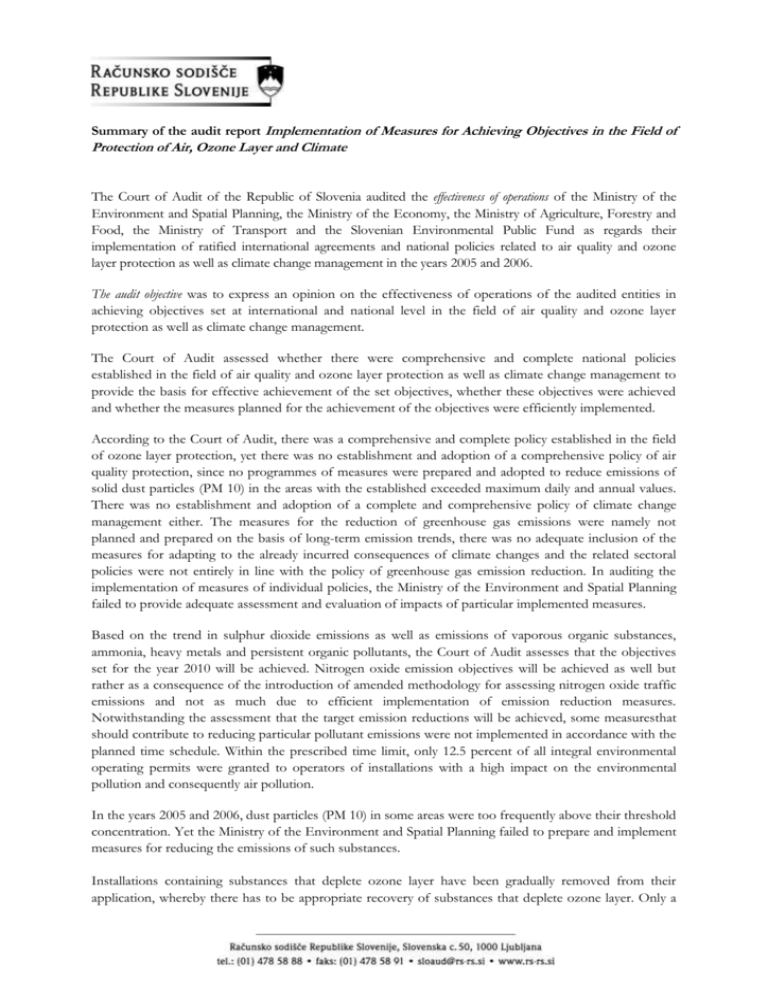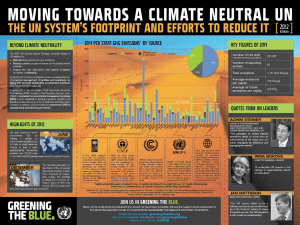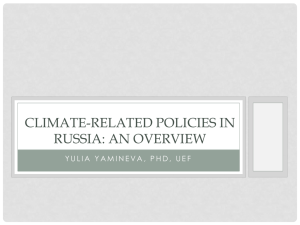Report abstract
advertisement

Summary of the audit report Implementation of Measures for Achieving Objectives in the Field of Protection of Air, Ozone Layer and Climate The Court of Audit of the Republic of Slovenia audited the effectiveness of operations of the Ministry of the Environment and Spatial Planning, the Ministry of the Economy, the Ministry of Agriculture, Forestry and Food, the Ministry of Transport and the Slovenian Environmental Public Fund as regards their implementation of ratified international agreements and national policies related to air quality and ozone layer protection as well as climate change management in the years 2005 and 2006. The audit objective was to express an opinion on the effectiveness of operations of the audited entities in achieving objectives set at international and national level in the field of air quality and ozone layer protection as well as climate change management. The Court of Audit assessed whether there were comprehensive and complete national policies established in the field of air quality and ozone layer protection as well as climate change management to provide the basis for effective achievement of the set objectives, whether these objectives were achieved and whether the measures planned for the achievement of the objectives were efficiently implemented. According to the Court of Audit, there was a comprehensive and complete policy established in the field of ozone layer protection, yet there was no establishment and adoption of a comprehensive policy of air quality protection, since no programmes of measures were prepared and adopted to reduce emissions of solid dust particles (PM 10) in the areas with the established exceeded maximum daily and annual values. There was no establishment and adoption of a complete and comprehensive policy of climate change management either. The measures for the reduction of greenhouse gas emissions were namely not planned and prepared on the basis of long-term emission trends, there was no adequate inclusion of the measures for adapting to the already incurred consequences of climate changes and the related sectoral policies were not entirely in line with the policy of greenhouse gas emission reduction. In auditing the implementation of measures of individual policies, the Ministry of the Environment and Spatial Planning failed to provide adequate assessment and evaluation of impacts of particular implemented measures. Based on the trend in sulphur dioxide emissions as well as emissions of vaporous organic substances, ammonia, heavy metals and persistent organic pollutants, the Court of Audit assesses that the objectives set for the year 2010 will be achieved. Nitrogen oxide emission objectives will be achieved as well but rather as a consequence of the introduction of amended methodology for assessing nitrogen oxide traffic emissions and not as much due to efficient implementation of emission reduction measures. Notwithstanding the assessment that the target emission reductions will be achieved, some measuresthat should contribute to reducing particular pollutant emissions were not implemented in accordance with the planned time schedule. Within the prescribed time limit, only 12.5 percent of all integral environmental operating permits were granted to operators of installations with a high impact on the environmental pollution and consequently air pollution. In the years 2005 and 2006, dust particles (PM 10) in some areas were too frequently above their threshold concentration. Yet the Ministry of the Environment and Spatial Planning failed to prepare and implement measures for reducing the emissions of such substances. Installations containing substances that deplete ozone layer have been gradually removed from their application, whereby there has to be appropriate recovery of substances that deplete ozone layer. Only a third of such substances have been appropriately recovered. The Ministry of the Environment and Spatial Planning did not efficiently monitor and control the recovery of ozone depleting substances from installations containing such substances and did not adequately control whether operators regularly check tightness of their installations. Since 1992, greenhouse gas emissions have continuously increased. Unplanned emission growth is a consequence of changed economic situation and unsatisfactory level of implementation of emission reduction measures, especially in the field of energy and transport. In the years 2005 and 2006, the planned emission reduction effects in the framework of the implementation of measures related to efficient use of energy and promotion of the use of energy from renewable sources failed to be achieved, especially owing to the underimplementation of investments with such effects due to inadequate funds for direct incentives granted by the Ministry of the Environment and Spatial Planning and for attractive loans granted by the Environmental Fund of the Republic of Slovenia. The allocation of available funds was not efficient for it was possible to obtain simultaneously a grant and attractive loan for the same investment irrespective of the demand for subsidies exceeding their offer. Investment effects were assessed in both instances. The achieved effects were thus overestimated. Planning of the future implementation of measures was not efficient, which lessens the possibility of achieving the set objectives of reducing greenhouse gas emissions. In the energy sector, the Ministry of the Environment and Spatial Planning failed to provide adequate funds for the implementation of the planned volume of investments in the framework of the implementation of measures for increasing the efficient use of energy and promoting the use of energy from renewable sources. In the transport sector, the Ministry of Transport did not plan measures for redirecting freight transport from roads to railways and neither did it plan measures for increasing the proportion of public passenger transport. No funds were provided for their implementation either. As regards the emission reduction, the Ministry of the Environment and Spatial Planning overly emphasised emission credit trading, even though the trading is considered a Kyoto mechanism, which should notably present a measure supplementary to domestic measures. Despite the concluded international agreement on the reduction of greenhouse gas emissions, the achievement of the agreed objectives was not deemed a priority in the allocation of budgetary resources. There is no transparency in the assessment of the achieved effects of measures for the reduction of greenhouse gas emissions by sectors. The reduction of greenhouse gas emissions is considered an indirect effect of many sectoral measures implemented by the Ministry of Agriculture, Forestry and Food, the Ministry of the Economy and the Ministry of Transport; however, this was not appropriately evaluated by the audited ministries. For the established ineffectiveness to be eliminated, the Court of Audit demanded from the Ministry of the Environment and Spatial Planning the submission of a response report and all the auditees were provided recommendations for the improvement of their operations. Ljubljana, 9 June 2008 2









